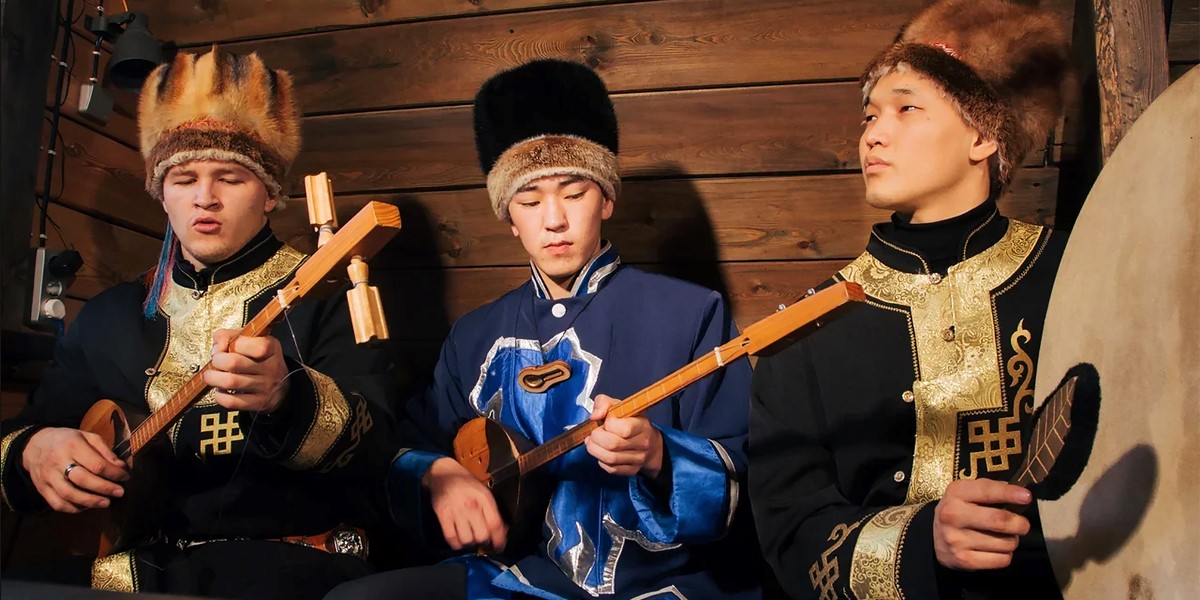Friday, October 1, 2021
Introducing... Bai-Terek
By Dan Shutt
A young throat singing trio from the mountainous Altai Republic are rapidly gaining a worldwide fanbase thanks to their online videos. Dan Shutt reports

Bai-Terek (photo by Elizoveta Moroz)
The spirit of the Altai moves in threes, across the lower, middle and upper worlds. Similarly, the tree (Bai-Terek means poplar) has its roots in the earth, its trunk on the ground and its leaves in the sky. Ezendey Balbin, Danil Danzheev and Aian Enchinov, while only 19, 21 and 22 years old respectively, are already masters of their instruments and of singing in the karkyraa (lower), khöömii (middle) and sygyt (upper) overtonal voices.
Bai-Terek released their debut album, Spirit of Altai, on March 31 to an adoring international audience, which they have built up and nurtured through enthusiastic use of Instagram and a series of widely-shared videos for the Russian YouTube channel VEK under their previous name, Altyn Tuu.
The intensity of their home landscape and way of life is clear in the music, clothing and stories of the Siberian indigenous populations, and Bai-Terek add to this the joyous intensity of youth. They wrote their most recent songs way out in the mountains, populated almost exclusively by shepherds and completed their album recording sessions at night, spending the days sleeping. The sounds of the steppes – horses, wind, water – are a key part of their extravagant sonic textures, all replicated with their own voices.
Singing is by necessity a bodily act, and throat singing requires extreme physical strength alongside an ability to listen not just with the ear, but with the chest, throat, head. It is appropriate that Danil Danzheev, who often sings the lead vocal on the group’s compositions, is an active wrestler. Likewise, Ezendey (Altai for ‘Friendly’) Balbin taps into a deep inner strength to achieve extraordinary whistles and vocal trills that have been a key point of attraction for the group’s non-Altai fanbase.
The Altai Mountains stretch across the borders of the Russian Federation, Mongolia, China and Kazakhstan, with the region’s current boundaries reflecting its intricate history. The three members of Bai-Terek identify as being of the Kipchak, Kobok and Hongodor ‘clans’, with home towns stretching from Lake Baikal to Barnaul almost 2,000 kilometres away. Yet even across such vast distances they share a consistent artistic style. Their music, all original compositions recorded with Ivan Sorokin and mixed by Solun Mendeshev of the Baikal Theatre, shares similarities with much from the surrounding region. Many of their instruments are played throughout the Altai, too, including the tovshuur (two-stringed lute with 21 frets), ikili (two-stringed bowed lute), tsuur (Altai flute), tunur (drum) and komuz (jaw harp). Some of these instruments are made for the group by Aian Enchinov’s father, Alexey, a master instrument-builder.
What sets their music apart is that it is not so much an attempt to fuse ‘old’ and ‘new,’ but that it achieves a coming together of tradition and genuine passion for contemporary music; among the group’s listed influences are deep house and Frank Ocean.
Performing in Siberia is arduous, with Bai Terek clocking 1,800 kilometres on their latest tour, but wherever they go in future – whether in the lower, middle or upper world – they will certainly be well received.
This article originally appeared in the August/September 2021 issue of Songlines. Never miss an issue – subscribe today

